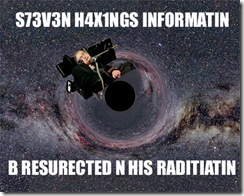The Black hole information paradox results from the combination of quantum mechanics and general relativity. It suggests that physical information could "disappear" in a black hole. It was a contentious subject for science since it violated a commonly assumed tenet of science—that information cannot be destroyed.
In 1975, Stephen Hawking and Jacob Bekenstein showed that black holes should slowly radiate away energy, which poses a problem. From the no hair theorem one would expect the Hawking radiation to be completely independent of the material entering the black hole. However, if the material entering the black hole were a pure quantum state, the transformation of that state into the mixed state of Hawking radiation would destroy information about the original quantum state. This violates Liouville's theorem and presents a physical paradox.
More precisely, if we have an entangled pure state and we throw in one part of the entangled system into the black hole while keeping the other part outside, we get a mixed state after we take the partial trace over the interior of the black hole. But since everything within the interior of the black hole will hit the singularity within a fixed finite time, the part which is traced over partially might "disappear", never to appear again. Of course, we don't really know what goes on at singularities once quantum effects are taken into account, which is why this is conjectural and controversial.
Hawking was convinced, however, because of the simple elegance of the resulting equation which 'unified' Thermodynamics, Relativity, Gravity and Hawking's own work on the Big Bang. This annoyed many physicists, notably John Preskill, who in 1997 bet Hawking and Kip Thorne that information was not lost in black holes. In 2004 Hawking had to pay out to Preskill when Hawking conceded that Preskill was in fact correct.
There are various ideas about how the paradox is solved. Since the 1998 proposal of the AdS/CFT correspondence, the predominant belief among physicists is that information is preserved and that Hawking radiation is not precisely thermal but receives quantum corrections. Other possibilities include the information being contained in a Planckian remnant left over at the end of Hawking radiation or a modification of the laws of quantum mechanics to allow for non-unitary time evolution.
In July 2004 Stephen Hawking announced a theory that quantum perturbations of the event horizon could allow information to escape from a black hole, which would resolve the information paradox. Basically, his argument assumes the AdS/CFT correspondence which states that an AdS black hole is dual to a thermal conformal field theory, which is unitary. However, as of 2004 the full details of the theory have yet to be published, so most peers are reserving judgment before accepting the result. When announcing his result, Hawking also conceded the 1997 bet, paying Preskill with a baseball encyclopedia (ISBN 1-894963-27-X) 'from which information can be retrieved at will'. Thorne, however, remains unconvinced of Hawking's proof and declined to contribute to the award.
Paradoxul lui Hawking part.2 – Subtitrare in romana
Download from here :
Technorati Tags: Paradox,Stephen Hawking,Bekenstein,Thermodynamics,Preskill,Thorne,Planckian,quantum,mechanics,physical,
science,black holes,theorem,radiation,time,physicists,thermal,unitary.
WordPress Tags: Paradox,Stephen Hawking,Bekenstein,Thermodynamics,Preskill,Thorne,Planckian,quantum,mechanics,physical,
science,black holes,theorem,radiation,time,physicists,thermal,unitary.
science,black holes,theorem,radiation,time,physicists,thermal,unitary.

Trimiteți un comentariu
Trimiteți un comentariu